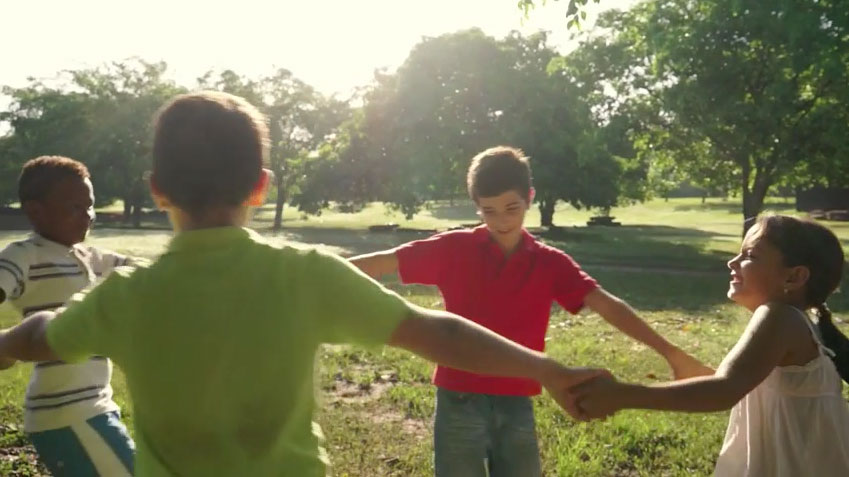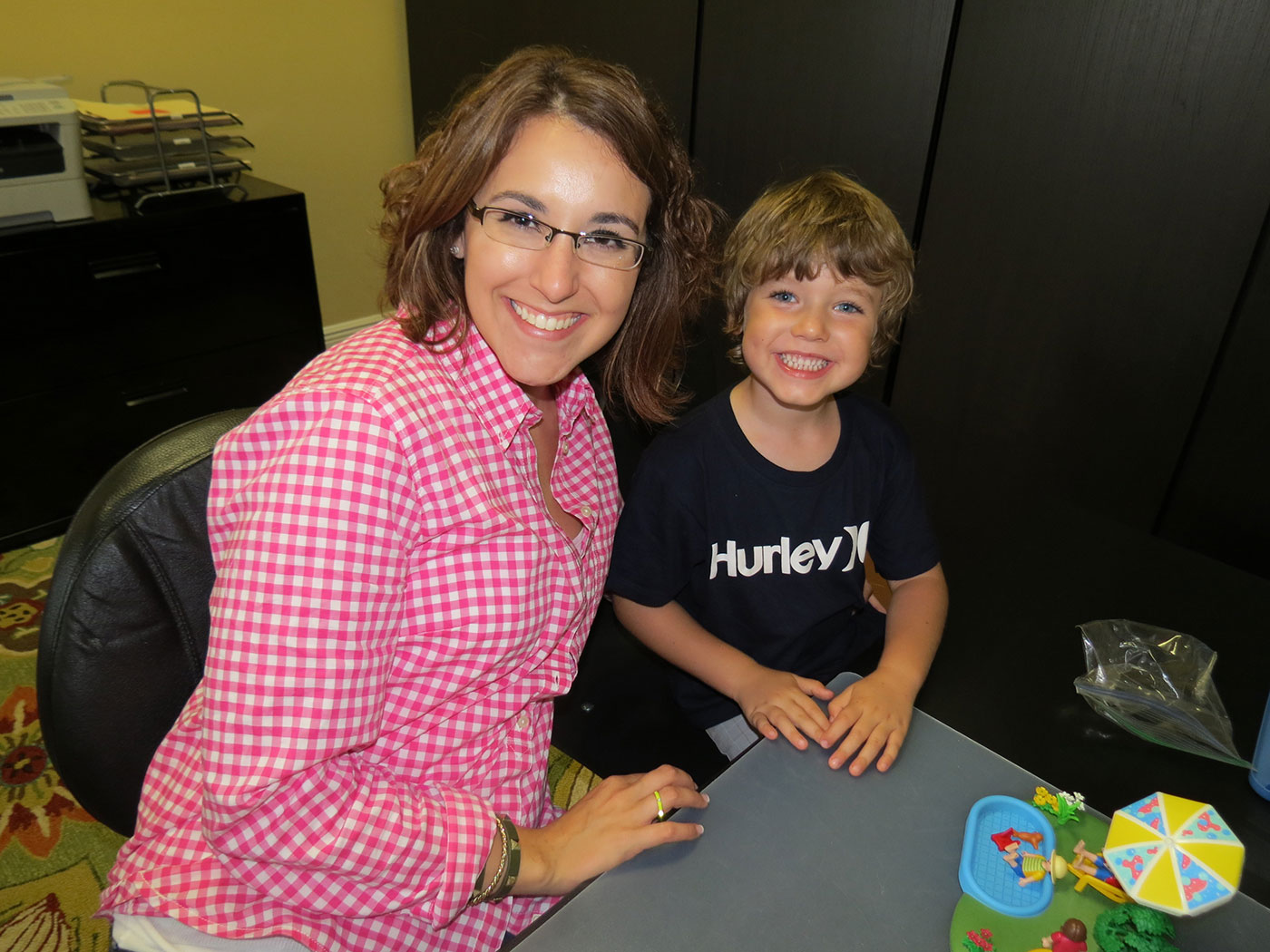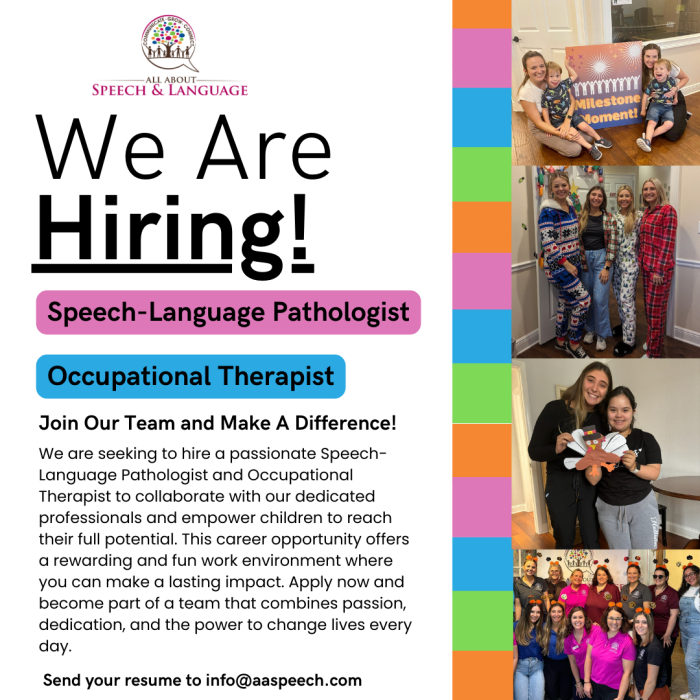Occupational Therapy
-

Occupational Therapy Development
All About Speech & Language Occupational Therapists are skilled at assessing and improving a variety
of physical, cognitive, and sensory skills that are an important part of your child’s overall development.
For the child, everyday activities include learning through play, developing independence skills, and interacting with others; occupational therapists work to help children make gains across these areas, which often positively supports speech and language development.
learn more -

Rythmic Entrainment Intervention (REI)
All About Speech and Language offers Rhythmic Entrainment Intervention (REI), a valuable approach to incorporate into your child’s therapy sessions. REI uses auditory rhythm to effect neurological functions. It is evidenced-based and has been proven through research and studies to effect calming, alertness, improved sleep patterns, sensory processing and ability to sustain attention for longer periods of time. REI is an additional treatment intervention that is utilized during treatment sessions and/or and at home.
learn more -

Handwriting
All About Speech & Language provides speech-language pathologists to assist with writing skills, particularly in the formulation process (combining words into sentences, sentences into paragraphs, organization, editing skills, etc.). The physical “act” of writing (also known as handwriting) is best remediated through work with an occupational therapist to address these fine-motor skills and associated abilities.
learn more
-
Comprehensive Occupational Therapy Screenings and Evaluations
We provide occupational therapy screenings to address concerns that parents and/or other professionals and teachers may have about a child’s development. Recommendations are made for evaluations based on the results of a screening. Evaluations are warranted for new patients who have not already received an evaluation and at 6-month to 1-year intervals for re-evaluations to document progress since starting therapy. Comprehensive evaluations allow the occupational therapist to assess your child across writing, social, and play modalities, as it is appropriate for his/her age and development. -
Consultations and Parent Support
We are available to speak with other professionals about a particular client at the request of a parent, in addition to providing parent support via direct meetings, phone calls, and emails about their concerns and his/her child’s diagnosis, therapeutic process, and progress in therapy. -
School In-Services for Faculty and Parents
Providing information to empower teachers, parents, and caregivers on cognitive, social emotional, and motor developmental milestones and red flags to consider pertaining to a variety of developmental disorders. -
Interactive Metronome Program
This is a visual-auditory program via the use of computerized metronome to help coordinate “neural timing” to aid children and adults in focusing, attending, processing information, recalling and remembering, as well as in coordinating his/her motor system for movement. This program is successfully used alongside functional therapy interventions for individuals with and without disorders such as Apraxia, ADHD, Autism Spectrum, Dyslexia, Reading, Auditory Processing Disorders, Brain injury, and more, as well as to enhance cognitive and athletic performance. -
Social Dyads
Social Dyads are 2 peers working with a Speech and Occupational therapist together. -
Co-treatment
1 child to a Speech and Occupational therapist
All About Speech & Language’s Areas of Expertise:
Individual and collaborative group treatment for occupational therapy across a variety of disorder areas and abilities.
-
Sensory Processing Disorder
The way in which our bodies receive, interpret, and respond to messages from our senses, including: touch, sight, sound, movement, body awareness, taste, and smell, is called sensory processing. Sensory processing issues arise when these messages are missed or misinterpreted, resulting in difficulties organizing, processing, and responding appropriately to everyday environmental stimuli. Inefficient sensory responses can be categorized as hypersensitive (over-responsive to certain stimuli), hyposensitive (under-responsive to certain stimuli), or a combination of both. Common signs of hypersensitivities may include: intense or fearful reactions to unexpected or loud noises, constantly covering eyes or overly bothered by lights, avoiding certain textures and/or having an extreme response to being touched or in close proximity to others, shying away from playground equipment, and/or limiting diet to bland or soft food items. Common signs of hyposensitivites may include: constantly touching others and objects in the environment, appearing overly clumsy, seemingly unbothered by pain and/or is unaware of own strength, having difficulty sitting still, seeking out bright lights and/or loud noises. At times, many children may appear to have quirky or rigid likes/dislikes, but children with Sensory Processing Disorder (also referred to as Sensory Integration Dysfunction) are so chronically and significantly affected by their preferences that they are unable to efficiently participate in everyday roles and activities. An occupational therapist (OT) evaluates a child’s ability to integrate sensory input through a variety of assessments, caregiver reports/interviews, and clinical observations. Sensory integrative therapy is implemented to help the child appropriately register information retrieved the environment (through sight, sound, touch, smell, and taste), as well as internally (through movement and body awareness), appropriately process that information and use it to form an adaptive response. Therapeutic techniques and interventions are creative, fun, child-centered, and often implemented through play activities designed to modify the ways in which the child’s brain responds to sensory input. In addition to providing therapy in the clinic, an OT will work with your family to develop a “sensory diet” to facilitate carry over of learned strategies into the home and school settings. This “sensory diet” is a personalized and detailed activity plan used to achieve and maintain an optimal level of arousal and attention for your child throughout the day by use of sensory strategies. Sufficient modulation of sensory input is critical to a child’s development and his or her ability to learn and master foundational skills. The goal of sensory integrative therapy is to provide your child with the tools he or she needs to better interpret and process sensory information, and in turn improve his or her ability to participate successfully and independently in everyday tasks. To learn more about Sensory Processing and Integration Disorders, contact one of our occupational therapists today. -
Fine motor
Fine motor skills refer to the control and coordination of the small muscle groups of the hands and fingers. These skills rapidly grow and develop during early childhood as children learn to manipulate small toys such as building block towers and stringing beads, functionally use drawing and cutting tools such as crayons and scissors, and complete age appropriate self-care tasks such as opening and closing clothing fasteners and eating with a spoon and fork. When a child experiences a delay in fine motor skill development, he or she may exhibit avoidance in the aforementioned tasks or with activities requiring dexterous use of the hands. If fine motor skills deficits are left without intervention, the child may begin to experience academic difficulties, impaired ability to gain independence in self-care, and challenges engaging in functional and meaningful play. An occupational therapist (OT) evaluates a child’s fine motor development through a battery of standardized measures and through clinical observations to determine if skills are delayed and to identify any other compound issues, such as a visual motor impairment or decreased core strength. Utilizing a variety of treatment approaches, an OT then works with the child and family to address deficit areas needed for improved performance in fine motor activities. Therapy sessions are structured to progress the child through the developmental stages of motor skill acquisition. The goal of therapy is to maximize the child’s independence and successful participation in all home, school, and community roles. You may refer to the developmental milestones chart listed above to see if your child’s fine motor skill growth is on target. To learn more about fine motor development or to request Occupational Therapy consultation and/or evaluation, contact one of our OTs today. -
Visual motor
Visual motor skills refer to the set of skills developed from the integration of visual acuity, visual perception, and motor coordination. Visual acuity is the physical ability to see an image sharply and clearly; visual perception is the ability to interpret and make sense of what we are seeing; and motor coordination is the ability to produce purposeful, skilled, coordinated movements. These primary systems work together to enable us to organize our eye-hand use in an efficient, coordinated manner. Visual motor skills are essential for tasks such as writing on lined paper or copying from the board, sorting shapes or completing puzzles, following designs to build blocks or legos, cutting out shapes within the borders, completing mazes, orienting clothing correctly, catching and throwing a ball. When visual and motor systems are not effectively communicating, children may experience difficulties with many of these types of activities. Difficulties with visual motor skills may be caused by limited acuity, deficits in visual perception, poor fine or gross motor skills, or a combination of some or all of these. If left without intervention, the child may begin to experience academic difficulties, challenges with self-care, trouble playing with age appropriate toys and participating in age appropriate activities such as sports or dance teams. An occupational therapist (OT) evaluates a child’s visual and motor development to identify potential deficits and determine the age appropriateness of the child’s skill set. Following an evaluation, the OT will develop a treatment plan based on the child’s performance and targeted at improving visual motor skills and underlying or compound deficits. Individualized, skilled interventions will guide the child through a progression from simple visual processing exercises to completion of complex tasks, building upon the child’s strengths and interests. The goal of therapy is to maximize a child’s independence and his or her successful participation in all home, school, and community roles. To learn more about visual motor development or to request Occupational Therapy consultation and/or evaluation, contact one of our OTs today.







